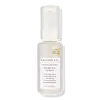What's inside
What's inside
 Key Ingredients
Key Ingredients

 Benefits
Benefits

 Concerns
Concerns

 Ingredients Side-by-side
Ingredients Side-by-side

Cyclotetrasiloxane
EmollientCyclopentasiloxane
EmollientDimethiconol
EmollientParfum
MaskingWater
Skin ConditioningCetearamidoethyldiethonium Succinoyl Hydrolyzed Pea Protein
CleansingHypnea Musciformis Extract
Skin ProtectingGlycerin
HumectantSargassum Filipendula Extract
Skin ProtectingSorbitol
HumectantCaprylic/Capric Triglyceride
MaskingChamomilla Recutita Flower Extract
MaskingHelianthus Annuus Seed Oil
EmollientMangifera Indica Seed Butter
Skin ConditioningPersea Gratissima Oil
Skin ConditioningRicinus Communis Seed Oil
MaskingCoco-Glucoside
CleansingGelidiella Acerosa Extract
Skin ProtectingArgania Spinosa Kernel Oil
EmollientSimmondsia Chinensis Seed Oil
EmollientTetrahexyldecyl Ascorbate
AntioxidantCoffea Arabica Seed Oil
MaskingBisabolol
MaskingPhenoxyethanol
PreservativeTocopherol
AntioxidantAlgin
MaskingCarrageenan
Chitosan
Guar Hydroxypropyltrimonium Chloride
Skin ConditioningSorbitan Oleate
EmulsifyingXanthan Gum
EmulsifyingGlycine Soja Oil
EmollientEthylhexylglycerin
Skin ConditioningZingiber Officinale Root Extract
MaskingCyclotetrasiloxane, Cyclopentasiloxane, Dimethiconol, Parfum, Water, Cetearamidoethyldiethonium Succinoyl Hydrolyzed Pea Protein, Hypnea Musciformis Extract, Glycerin, Sargassum Filipendula Extract, Sorbitol, Caprylic/Capric Triglyceride, Chamomilla Recutita Flower Extract, Helianthus Annuus Seed Oil, Mangifera Indica Seed Butter, Persea Gratissima Oil, Ricinus Communis Seed Oil, Coco-Glucoside, Gelidiella Acerosa Extract, Argania Spinosa Kernel Oil, Simmondsia Chinensis Seed Oil, Tetrahexyldecyl Ascorbate, Coffea Arabica Seed Oil, Bisabolol, Phenoxyethanol, Tocopherol, Algin, Carrageenan, Chitosan, Guar Hydroxypropyltrimonium Chloride, Sorbitan Oleate, Xanthan Gum, Glycine Soja Oil, Ethylhexylglycerin, Zingiber Officinale Root Extract
Water
Skin ConditioningCera Alba
EmollientDimethicone
EmollientIsopropyl Myristate
EmollientPhenoxyethanol
PreservativeHydroxypropyl Guar
Emulsion StabilisingPEG-40 Hydrogenated Castor Oil
EmulsifyingTriethanolamine
BufferingHydroxyethylcellulose
Emulsion StabilisingCaprylyl Glycol
EmollientDimethiconol
EmollientPEG-30 Glyceryl Stearate
EmulsifyingHydrogenated Styrene/Butadiene Copolymer
Ethylhexylglycerin
Skin ConditioningAcrylates/C10-30 Alkyl Acrylate Crosspolymer
Emulsion StabilisingHexyl Cinnamal
PerfumingLinalool
PerfumingDisodium Stearoyl Glutamate
CleansingCitronellol
PerfumingGeraniol
PerfumingBenzyl Alcohol
PerfumingLimonene
PerfumingHydroxycitronellal
PerfumingBenzyl Salicylate
PerfumingAlpha-Isomethyl Ionone
PerfumingPEG-30 Dipolyhydroxystearate
EmulsifyingTrideceth-6
EmulsifyingHydrolyzed Wheat Protein
Skin ConditioningCitral
PerfumingHydrolyzed Corn Protein
Skin ConditioningHydrolyzed Soy Protein
HumectantTocopherol
AntioxidantParfum
MaskingWater, Cera Alba, Dimethicone, Isopropyl Myristate, Phenoxyethanol, Hydroxypropyl Guar, PEG-40 Hydrogenated Castor Oil, Triethanolamine, Hydroxyethylcellulose, Caprylyl Glycol, Dimethiconol, PEG-30 Glyceryl Stearate, Hydrogenated Styrene/Butadiene Copolymer, Ethylhexylglycerin, Acrylates/C10-30 Alkyl Acrylate Crosspolymer, Hexyl Cinnamal, Linalool, Disodium Stearoyl Glutamate, Citronellol, Geraniol, Benzyl Alcohol, Limonene, Hydroxycitronellal, Benzyl Salicylate, Alpha-Isomethyl Ionone, PEG-30 Dipolyhydroxystearate, Trideceth-6, Hydrolyzed Wheat Protein, Citral, Hydrolyzed Corn Protein, Hydrolyzed Soy Protein, Tocopherol, Parfum
Ingredients Explained
These ingredients are found in both products.
Ingredients higher up in an ingredient list are typically present in a larger amount.
Dimethiconol is a silicone that resembles the popular dimethicone. Like other silicones, it is an emollient. Emollients create a thin film on skin to prevent moisture from escaping.
This ingredient helps to create a silky texture and improve spreadability. Due to its high molecular weight and thickness, it is often combined with cyclopentasiloxane.
Ethylhexylglycerin (we can't pronounce this either) is commonly used as a preservative and skin softener. It is derived from glyceryl.
You might see Ethylhexylglycerin often paired with other preservatives such as phenoxyethanol. Ethylhexylglycerin has been found to increase the effectiveness of these other preservatives.
Parfum is a catch-all term for an ingredient or more that is used to give a scent to products.
Also called "fragrance", this ingredient can be a blend of hundreds of chemicals or plant oils. This means every product with "fragrance" or "parfum" in the ingredients list is a different mixture.
For instance, Habanolide is a proprietary trade name for a specific aroma chemical. When used as a fragrance ingredient in cosmetics, most aroma chemicals fall under the broad labeling category of “FRAGRANCE” or “PARFUM” according to EU and US regulations.
The term 'parfum' or 'fragrance' is not regulated in many countries. In many cases, it is up to the brand to define this term.
For instance, many brands choose to label themselves as "fragrance-free" because they are not using synthetic fragrances. However, their products may still contain ingredients such as essential oils that are considered a fragrance by INCI standards.
One example is Calendula flower extract. Calendula is an essential oil that still imparts a scent or 'fragrance'.
Depending on the blend, the ingredients in the mixture can cause allergies and sensitivities on the skin. Some ingredients that are known EU allergens include linalool and citronellol.
Parfum can also be used to mask or cover an unpleasant scent.
The bottom line is: not all fragrances/parfum/ingredients are created equally. If you are worried about fragrances, we recommend taking a closer look at an ingredient. And of course, we always recommend speaking with a professional.
Learn more about ParfumPhenoxyethanol is a preservative that has germicide, antimicrobial, and aromatic properties. Studies show that phenoxyethanol can prevent microbial growth. By itself, it has a scent that is similar to that of a rose.
It's often used in formulations along with Caprylyl Glycol to preserve the shelf life of products.
Tocopherol (also known as Vitamin E) is a common antioxidant used to help protect the skin from free-radicals and strengthen the skin barrier. It's also fat soluble - this means our skin is great at absorbing it.
Vitamin E also helps keep your natural skin lipids healthy. Your lipid skin barrier naturally consists of lipids, ceramides, and fatty acids. Vitamin E offers extra protection for your skin’s lipid barrier, keeping your skin healthy and nourished.
Another benefit is a bit of UV protection. Vitamin E helps reduce the damage caused by UVB rays. (It should not replace your sunscreen). Combining it with Vitamin C can decrease sunburned cells and hyperpigmentation after UV exposure.
You might have noticed Vitamin E + C often paired together. This is because it is great at stabilizing Vitamin C. Using the two together helps increase the effectiveness of both ingredients.
There are often claims that Vitamin E can reduce/prevent scarring, but these claims haven't been confirmed by scientific research.
Learn more about TocopherolWater. It's the most common cosmetic ingredient of all. You'll usually see it at the top of ingredient lists, meaning that it makes up the largest part of the product.
So why is it so popular? Water most often acts as a solvent - this means that it helps dissolve other ingredients into the formulation.
You'll also recognize water as that liquid we all need to stay alive. If you see this, drink a glass of water. Stay hydrated!
Learn more about Water